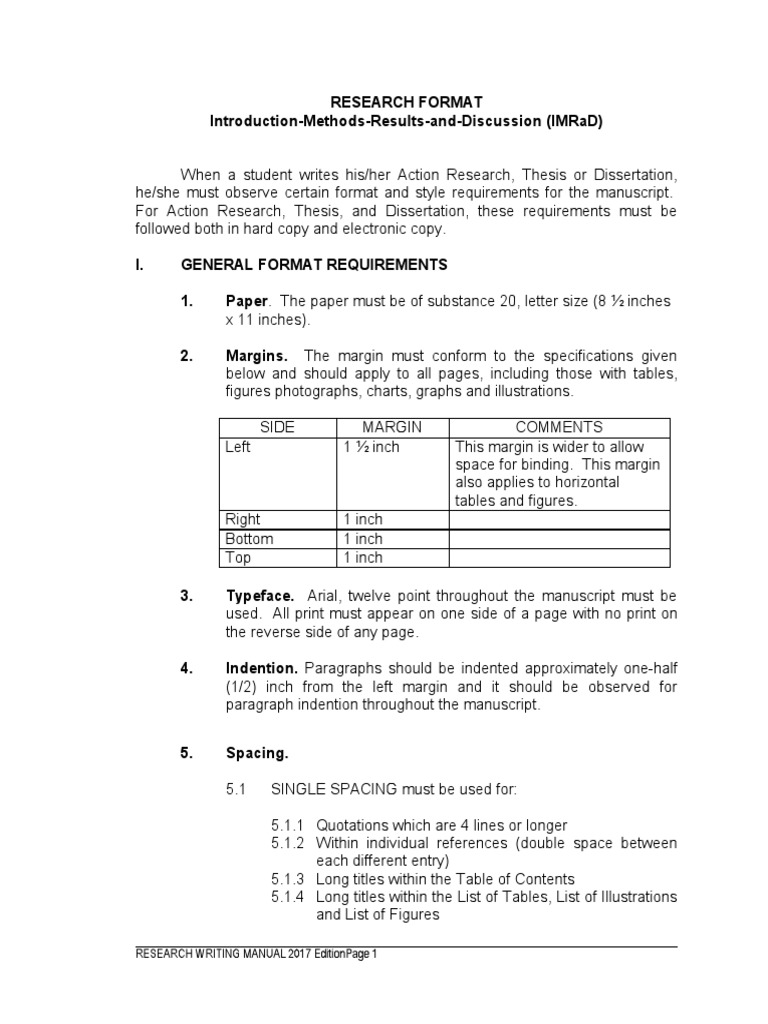
Outline of Scholarly Writing
15/06/ · IMRaD is an acronym for Introduction, Methods, Results, and Discussion. It describes the format for the sections of a research report. The IMRaD (or IMRD) format is often used in the social sciences, as well as in the STEM fields. IMRD: The Parts of a Research Paper. Credit: IMRD: The Parts of a Research Paper by Wordvice Editing Service on blogger.com: Michele Nicole Johnson Imrad- Sample-Research. a pattern for going quantitative research of a nursing student. University. Western Philippines University; Course. Nursing; Academic year. This paper reports on our experience in using realistic industry-oriented case studies in requirements in engineering course with graduate students. It indicates a strong From onward, the complete format is the most used. The New England Journal of Medicine had a slightly different pattern. Until , continuous text, non-IMRAD headings, and case reports predominated. After , the IMRAD structure takes the lead. As an example, Figure 2 shows the text organization in the British Medical Journal from to The ascending

What is IMRaD?
The IMRaD (often pronounced “im-rad”) format is a scientific writing structure that includes four or five major sections: introduction (I); research methods (M); results (R); analysis (a); and discussion (D). The IMRaD format is the most commonly used format in scientific article and journal writing and is used widely across most scientific and research fields “IMRaD” format refers to a paper that is structured by four main sections: Introduction, Methods, Results, and Discussion. This format is often used for lab reports as well as for reporting any planned, systematic research in the social sciences, natural sciences, or engineering and computer sciences. Introduction – Make a case for your research 15/06/ · IMRaD is an acronym for Introduction, Methods, Results, and Discussion. It describes the format for the sections of a research report. The IMRaD (or IMRD) format is often used in the social sciences, as well as in the STEM fields. IMRD: The Parts of a Research Paper. Credit: IMRD: The Parts of a Research Paper by Wordvice Editing Service on blogger.com: Michele Nicole Johnson

Post navigation
Imrad- Sample-Research. a pattern for going quantitative research of a nursing student. University. Western Philippines University; Course. Nursing; Academic year. This paper reports on our experience in using realistic industry-oriented case studies in requirements in engineering course with graduate students. It indicates a strong “IMRaD” format refers to a paper that is structured by four main sections: Introduction, Methods, Results, and Discussion. This format is often used for lab reports as well as for reporting any planned, systematic research in the social sciences, natural sciences, or engineering and computer sciences. Introduction – Make a case for your research The IMRaD (often pronounced “im-rad”) format is a scientific writing structure that includes four or five major sections: introduction (I); research methods (M); results (R); analysis (a); and discussion (D). The IMRaD format is the most commonly used format in scientific article and journal writing and is used widely across most scientific and research fields

Writing in Different Genres
The IMRaD (often pronounced “im-rad”) format is a scientific writing structure that includes four or five major sections: introduction (I); research methods (M); results (R); analysis (a); and discussion (D). The IMRaD format is the most commonly used format in scientific article and journal writing and is used widely across most scientific and research fields From onward, the complete format is the most used. The New England Journal of Medicine had a slightly different pattern. Until , continuous text, non-IMRAD headings, and case reports predominated. After , the IMRAD structure takes the lead. As an example, Figure 2 shows the text organization in the British Medical Journal from to The ascending Imrad- Sample-Research. a pattern for going quantitative research of a nursing student. University. Western Philippines University; Course. Nursing; Academic year. This paper reports on our experience in using realistic industry-oriented case studies in requirements in engineering course with graduate students. It indicates a strong

From onward, the complete format is the most used. The New England Journal of Medicine had a slightly different pattern. Until , continuous text, non-IMRAD headings, and case reports predominated. After , the IMRAD structure takes the lead. As an example, Figure 2 shows the text organization in the British Medical Journal from to The ascending “IMRaD” format refers to a paper that is structured by four main sections: Introduction, Methods, Results, and Discussion. This format is often used for lab reports as well as for reporting any planned, systematic research in the social sciences, natural sciences, or engineering and computer sciences. Introduction – Make a case for your research 15/06/ · IMRaD is an acronym for Introduction, Methods, Results, and Discussion. It describes the format for the sections of a research report. The IMRaD (or IMRD) format is often used in the social sciences, as well as in the STEM fields. IMRD: The Parts of a Research Paper. Credit: IMRD: The Parts of a Research Paper by Wordvice Editing Service on blogger.com: Michele Nicole Johnson
No comments:
Post a Comment